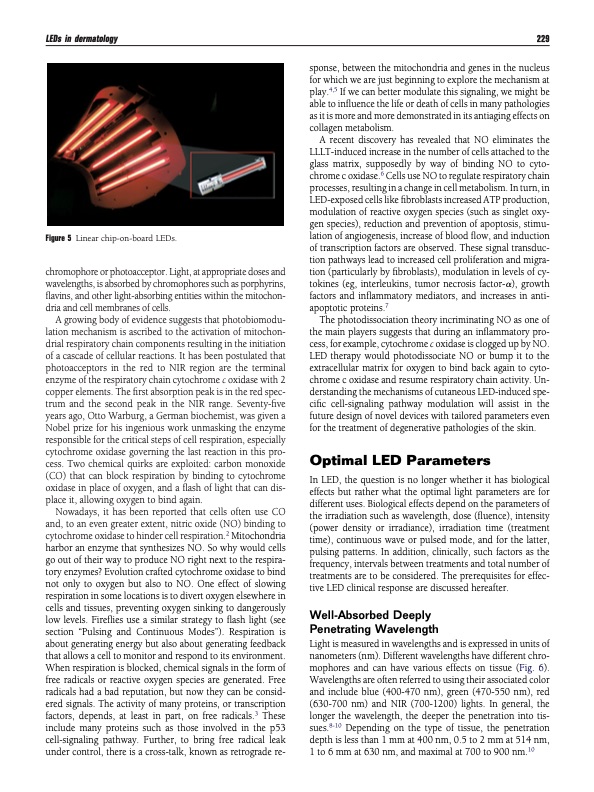
PDF Publication Title:
Text from PDF Page: 003
LEDs in dermatology 229 Figure 5 Linear chip-on-board LEDs. chromophore or photoacceptor. Light, at appropriate doses and wavelengths, is absorbed by chromophores such as porphyrins, flavins, and other light-absorbing entities within the mitochon- dria and cell membranes of cells. A growing body of evidence suggests that photobiomodu- lation mechanism is ascribed to the activation of mitochon- drial respiratory chain components resulting in the initiation of a cascade of cellular reactions. It has been postulated that photoacceptors in the red to NIR region are the terminal enzyme of the respiratory chain cytochrome c oxidase with 2 copper elements. The first absorption peak is in the red spec- trum and the second peak in the NIR range. Seventy-five years ago, Otto Warburg, a German biochemist, was given a Nobel prize for his ingenious work unmasking the enzyme responsible for the critical steps of cell respiration, especially cytochrome oxidase governing the last reaction in this pro- cess. Two chemical quirks are exploited: carbon monoxide (CO) that can block respiration by binding to cytochrome oxidase in place of oxygen, and a flash of light that can dis- place it, allowing oxygen to bind again. Nowadays, it has been reported that cells often use CO and, to an even greater extent, nitric oxide (NO) binding to cytochrome oxidase to hinder cell respiration.2 Mitochondria harbor an enzyme that synthesizes NO. So why would cells go out of their way to produce NO right next to the respira- tory enzymes? Evolution crafted cytochrome oxidase to bind not only to oxygen but also to NO. One effect of slowing respiration in some locations is to divert oxygen elsewhere in cells and tissues, preventing oxygen sinking to dangerously low levels. Fireflies use a similar strategy to flash light (see section “Pulsing and Continuous Modes”). Respiration is about generating energy but also about generating feedback that allows a cell to monitor and respond to its environment. When respiration is blocked, chemical signals in the form of free radicals or reactive oxygen species are generated. Free radicals had a bad reputation, but now they can be consid- ered signals. The activity of many proteins, or transcription factors, depends, at least in part, on free radicals.3 These include many proteins such as those involved in the p53 cell-signaling pathway. Further, to bring free radical leak under control, there is a cross-talk, known as retrograde re- sponse, between the mitochondria and genes in the nucleus for which we are just beginning to explore the mechanism at play.4,5 If we can better modulate this signaling, we might be able to influence the life or death of cells in many pathologies as it is more and more demonstrated in its antiaging effects on collagen metabolism. A recent discovery has revealed that NO eliminates the LLLT-induced increase in the number of cells attached to the glass matrix, supposedly by way of binding NO to cyto- chrome c oxidase.6 Cells use NO to regulate respiratory chain processes, resulting in a change in cell metabolism. In turn, in LED-exposed cells like fibroblasts increased ATP production, modulation of reactive oxygen species (such as singlet oxy- gen species), reduction and prevention of apoptosis, stimu- lation of angiogenesis, increase of blood flow, and induction of transcription factors are observed. These signal transduc- tion pathways lead to increased cell proliferation and migra- tion (particularly by fibroblasts), modulation in levels of cy- tokines (eg, interleukins, tumor necrosis factor-), growth factors and inflammatory mediators, and increases in anti- apoptotic proteins.7 The photodissociation theory incriminating NO as one of the main players suggests that during an inflammatory pro- cess, for example, cytochrome c oxidase is clogged up by NO. LED therapy would photodissociate NO or bump it to the extracellular matrix for oxygen to bind back again to cyto- chrome c oxidase and resume respiratory chain activity. Un- derstanding the mechanisms of cutaneous LED-induced spe- cific cell-signaling pathway modulation will assist in the future design of novel devices with tailored parameters even for the treatment of degenerative pathologies of the skin. Optimal LED Parameters In LED, the question is no longer whether it has biological effects but rather what the optimal light parameters are for different uses. Biological effects depend on the parameters of the irradiation such as wavelength, dose (fluence), intensity (power density or irradiance), irradiation time (treatment time), continuous wave or pulsed mode, and for the latter, pulsing patterns. In addition, clinically, such factors as the frequency, intervals between treatments and total number of treatments are to be considered. The prerequisites for effec- tive LED clinical response are discussed hereafter. Well-Absorbed Deeply Penetrating Wavelength Light is measured in wavelengths and is expressed in units of nanometers (nm). Different wavelengths have different chro- mophores and can have various effects on tissue (Fig. 6). Wavelengths are often referred to using their associated color and include blue (400-470 nm), green (470-550 nm), red (630-700 nm) and NIR (700-1200) lights. In general, the longer the wavelength, the deeper the penetration into tis- sues.8-10 Depending on the type of tissue, the penetration depthislessthan1mmat400nm,0.5to2mmat514nm, 1to6mmat630nm,andmaximalat700to900nm.10PDF Image | (LEDs) in Dermatology

PDF Search Title:
(LEDs) in DermatologyOriginal File Name Searched:
vol27_i4_Light-Emitting_Diodes.pdfDIY PDF Search: Google It | Yahoo | Bing
Cruise Ship Reviews | Luxury Resort | Jet | Yacht | and Travel Tech More Info
Cruising Review Topics and Articles More Info
Software based on Filemaker for the travel industry More Info
The Burgenstock Resort: Reviews on CruisingReview website... More Info
Resort Reviews: World Class resorts... More Info
The Riffelalp Resort: Reviews on CruisingReview website... More Info
| CONTACT TEL: 608-238-6001 Email: greg@cruisingreview.com | RSS | AMP |